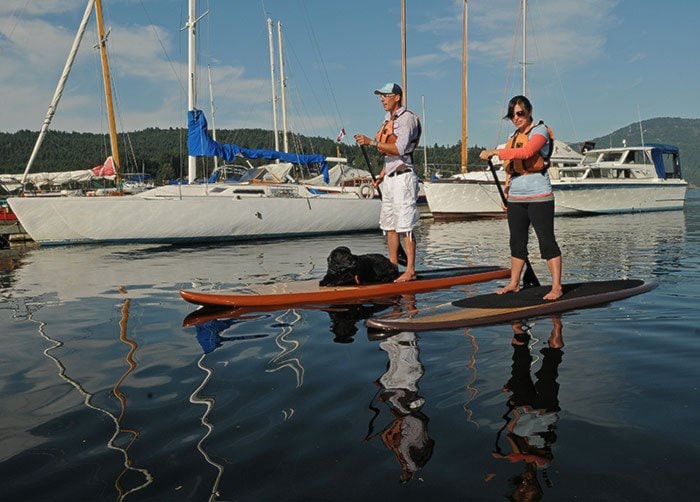Paddleboarding gives new meaning to walking on water
The most surprising thing about paddleboarding is that moment you don’t fall.
The board slips off the dock and into the water with me perched, quivering on top – a thick tightrope with no promise of ground to catch me. Somehow, I stay afloat.
“At first, a lot of people say it’s no worse than having a few too many drinks,” my guide Joshua Periard claims. “But it’s all in the mind. The only thing you have to do is to try and get your brain to stop overcompensating.”
Convincing the brain to loosen up is as easy as it sounds – it needs assurance. Within a few minutes, my central nervous system decides I’m not in imminent danger. The wobbling stills, my toes relax their death grip, my knees bend slightly and my breathing slows.
Then, my other senses recalibrate. My inner ears lay off equilibrium detection and start hearing the stillness; a seagull calls in the distance, water laps gently against the rocks. My eyes navigate from the horizon to take in the scenery: sun sparkles off the ocean ripples, sleepy boats float still on the bay. My joints become fluid again, and I inhale the clean morning air.
Any privileged, able-bodied person might think standing is no big deal. Most of us learned how to do it at six months of age, and many of us have since mastered the talent with little more reverence than we give breathing. Enter paddleboarding: the single best way to realize what an accomplishment it is to be bipedal. And by the time you move into paddleboard yoga – yes, that’s another thing Periard teaches through Pacifica Paddle Sports Inc. – balance is an art form.
“The thing I love, is that anyone can paddleboard,” says Periard, who has practically lived on the water since moving to the Island from Saskatchewan three years ago. “We have kids, grandparents, people with disabilities, even athletes come out, and so many of them think it will be hard, or not right for them, then they try it out and are amazed.”
Nervous laughter flits out of my mouth. I’ve now learned how to sit, kneel, hover, stand, even walk my feet around the board – kind of. While paddleboarding’s primary challenge is balance, moving is another thing. Standing confidently on his board, Periard looks back at me and smiles as my paddle starts to flow in the hook-shape pattern, special to the sport, he’s demonstrated. This motion keeps the board straight and forward, while side-to-side paddling causes the board to swagger dramatically.
The board isn’t the only dramatic element. Periard and I have been on the water for just 30 minutes when we see a coastal patrol boat heading our way. For a moment, I wonder if paddleboarding is jaywalking of the sea, but the officer calls out to make sure our lifejackets are secure, and moves on. A few moments later, we hear an enormous splash from the dock, and a creature the size of a large seal is paddling towards us – it’s Periard’s dog. Paris paddles over to Periard’s board and he pulls her up: it’s a bit of an advanced move.
“She doesn’t like me to go anywhere without her, so she’s been paddleboarding for a while too, now,” Periard tells me as he arranges her body and feet in front of his and the two blissfully glide through the water.
Another half hour passes, and by the time the three of us are heading back to shore, there is a deep serenity that floats along with us. A comfortable quiet echoes us home, the only sounds the brush of water and Paris’ panting. M
A brief history of paddleboarding
Paddleboarding might now be a chic sport for those buoyant with time and balance, but the activity started long ago as a mode of transportation for Hawaiians, says paddleboarding expert Joshua Periard.
Indigenous people may have used fallen logs to navigate island waterways, but stand up paddling, as we know it today, began in the 1960s when surfing instructors used the technique to position themselves for taking photographs. The idea caught on in California, where marketers pushed the technique for those who wanted a way to enjoy the water without the intense waves.
Even still, the sport has turned competitive, with the first Standup World Series championship races held last September at Turtle Bay Resort, O’Ahu, Hawaii.
The boards come in every size and style now, are filled with foam and range in design from glass-reinforced plastic construction to inflatable models. New boards range in price from $600 to $1,500 U.S., but renting models can be as inexpensive as $20 for the evening.
